Campaign launched to salute Edinburgh's greatest women
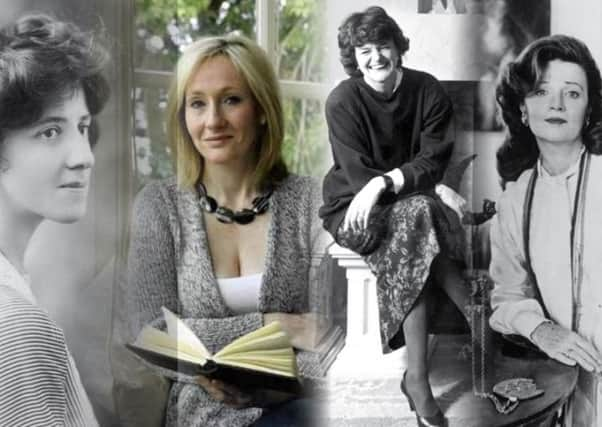

And the tribute to the woman dubbed “the heroine of Craigmillar”, who founded the Craigmillar Festival, has found a curious companion in one of history’s most iconic monarchs.
Five miles north of Helen’s statue is Leith’s Queen Victoria monument – the only other statue of a named woman in Edinburgh.
Advertisement
Hide AdAdvertisement
Hide AdIt is startling that, in a city stuffed full of statues, so few pay homage to the bold and brave women who have contributed to the betterment of our society. And even more astonishing is that the city’s statues of women are outnumbered by those of animals.
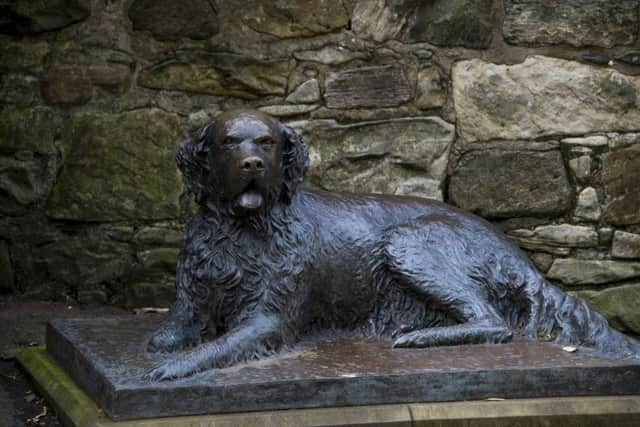

A statue was erected to Greyfriars Bobby in 1873, celebrating the story in which the Skye terrier refused to leave his master’s grave, even in the worst weather conditions.
He was joined by fellow loyal canine “Bum”, a vagabond dog who died in 1898 in San Diego, a city twinned with Edinburgh.
Bum’s statue was gifted to the Capital and sits at the Kings Stable Road entrance to Princes Street Gardens.
And in 2015, a statue immortalising beer-drinking Polish bear Wojtek – famous for “fighting” in World War Two and living out his days in Edinburgh Zoo – was unveiled.
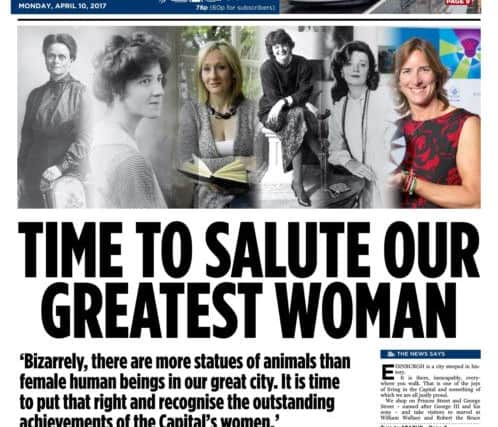

However, it is not the inclusion of Bobby, Bum and Wojtek that is galling but the sad lack of will to mark Edinburgh’s army of inspirational women – individuals whose achievements past and present are woven into the fabric of our everyday life.
For Allan Cumming, author of the Scottish Women’s Hospitals website, celebrating the contribution of women is of vital importance.
The landscape gardener has taken a special interest in Elsie Inglis, doctor and founder of the Scottish Women’s Hospitals, since hearing about her during a football trip to Serbia.
Advertisement
Hide AdAdvertisement
Hide AdThe founder of all-female field hospitals that served on the battlefields of Europe, Dr Inglis was one of the key figures in the development of medicine in Edinburgh.
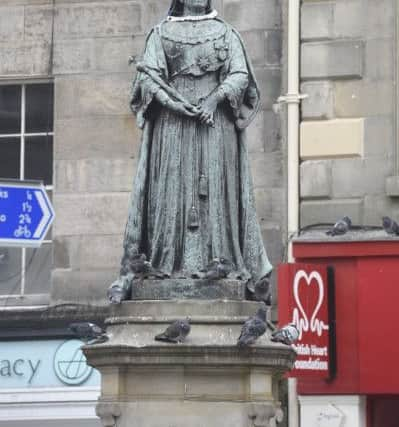

She also touched the lives of many Serbians whom she treated while stationed in the country during the First World War.
Mr Cumming said: “Dr Inglis means a great deal to people in Serbia. She features in many of the museums and is integral to their First World War story.
“She is very much loved and adored, and I feel people here know the name but they don’t know just how fantastic she was. She’s such a remarkable iconic character and deserves so much more.
“I thought the opening of the new medical facilities in Edinburgh would have been an ideal opportunity to use her name, but they haven’t.”
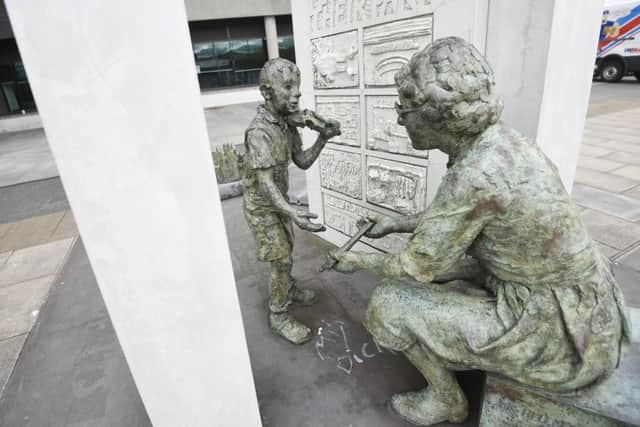

Elsie Inglis is just one of many women who have had a huge impact on the history of Edinburgh and Scotland.
Marie Stopes, who was born in the Capital in 1880, flouted controversy by writing and publishing an explicit sex manual, “Married Love”, which brought the subject of birth control to the forefront of post-war society.
Despite criticism from the church, the medical establishment and the press, she went on to found the first birth control clinic in Britain and fought throughout her life for women to have more control over family planning.
Advertisement
Hide AdAdvertisement
Hide AdToday, access to a university education is down to individual choice. Yet for seven brave women, accessing their right to education meant battling against significant opposition and monumental odds.
The Edinburgh Seven were Sophia Jex-Blake, Isabel Thorne, Edith Pechey, Matilda Chaplin, Helen Evans, Mary Anderson and Emily Bovell – the first women to be admitted on a degree programme at any British university.
Having enrolled to study medicine at Edinburgh University in 1869, their campaign put equality on the national political agenda, eventually resulting in legislation to ensure women could benefit from higher education in 1877.


Another remarkable figure in the city’s history is Eliza Wigham. Born in 1820, she was a leading light in the woman’s suffrage movement and a prominent anti-slavery campaigner.
Although the slave trade had been abolished 13 years before Eliza was born, it was still legal to own slaves. She became involved in several major campaigns to improve women’s rights and has been noted as one of the leading citizens of Edinburgh. Yet there is nothing recognising her achievement in her own city.
Then there is Muriel Spark – the creator of Miss Jean Brodie. The author and poet from Bruntsfield was born in 1918 and her unique characters were adapted for the theatre and screen. Her writing earned her a damehood in 1993.
Another world-renowned Edinburgh writer began her rags to riches story in an Old Town cafe. JK Rowling’s is a well-known story and the fictional world she created in the Harry Potter novels is even more famous. Her generosity has also contributed to helping women and children across Scotland.
In 2010, she donated £10 million to the University of Edinburgh to found a clinic in her mother’s name.
Advertisement
Hide AdAdvertisement
Hide AdThe Anne Rowling Regenerative Neurology Clinic is located at the Royal Infirmary in Little France and focuses on a wide range of neurological conditions.
Yet despite the popularity of the author’s books, her legacy in the city remains limited to tourist trails and an unofficial plaque squeezed into a door jam in Marchmont.
In the world of sport, few competitors are more inspiring than Katherine Grainger, who was honoured with an MBE in 2006 and a CBE in 2013 for services to rowing. She was also named Dame Commander of the Order of the British Empire (DBE) in the 2017 New Year Honours list.
Grainger is the most decorated female Olympian, having rowed her way into the record books as a gold and four-time silver medallist. She is also a six-time world champion.
Having taken up the sport at Edinburgh University, she was twice elected female athlete of the year by the institution’s sports union and, in 2008, was inducted to the university’s sports hall of fame.
Despite all the accomplishments of the Capital’s women over the centuries, their stories remain hidden – tucked away only to be unearthed on an anniversary or when a local group takes an interest and tries to make a change.
In 2012, a group of women took to the streets of Edinburgh dressed as heroines of the past to express frustration at the gender imbalance.
For Kate Joester, who helped organise the protest, the lack of monuments to individual women sends a damaging signal to girls and is something that must be changed. She said: “For little girls, it’s like, ‘who’s that up there?’ and I’m always having to explain to my daughter that it’s some bloke.
Advertisement
Hide AdAdvertisement
Hide Ad“If you do see a female statue, it’s usually a statue of an anonymous, generic woman – not of an individual. The city does not tell little girls that you can be amazing. In effect, in recognising only men, the city is in some way suggesting you have to be a man to achieve something incredible and be celebrated.”
What Do You Think?
Do you agree that we do not do to enough in Edinburgh to recognise the achievements of the city’s women?
If so, who would you like to see honoured and in what way? Would you be prepared to support a crowdfunding appeal to help pay for a statue?
Let us know by e-mailing Fiona Pringle at [email protected], writing to Fiona at Orchard Brae House or adding your comments on our website or Facebook page.
Stature: History to be proud of
Standing guard outside the Castle gates. We give directions past ‘the man on the horse’ statue, go to concerts at the Usher Hall and enjoy the Gothic splendour of the Scott Monument.
Our history is, quite literally, built into the fabric of the city.
But it is a very narrow view of our past that we celebrate in this way, with statues and major streets and buildings named after them. Where are all the women?
We have wonderful statues of Rabbie Burns, Walter Scott, Robert Louis Stephenson and Sherlock Holmes. Adam Smith, David Hume, John Knox and James Clerk Maxwell – towering historic figures to a man – are all immortalised in stone or bronze, as well as countless male monarchs, viscounts, politicians and scientists.
Advertisement
Hide AdAdvertisement
Hide AdBut you will search in vain for statues of the city’s great heroines.
Only the remarkable Helen Crummy – whose likeness stands outside Craigmillar library – and Queen Victoria are honoured in this way.
Where are the statues of medical pioneer and suffragette Elsie Inglis, Marie Stopes who set up the first birth control centre in Britain or Muriel Spark, one of Britain’s greatest 20th century writers? Or JK Rowling, Olympic great Katherine Grainger, or Maggie Keswick Jencks – of Maggie’s Centre fame – who has revolutionised cancer care around the world?
Bizarrely, there are more statues of animals than women in Edinburgh.
Does that matter? Well, yes, it does. And not just because of the message that it sends out to our children and visitors.
It is not the actual statues and grand public buildings named after men that count. It is the stories that we tell each other and the next generation that really matter.
Most of us grew up with tales of Burns and Stephenson, Wallace and Bruce, Adam Smith and John Knox. We remember these men and their stories because we have chosen collectively to do so.
We know they are great men partly because their statues tower over us as we walk the streets. These concrete reminders – or stone and bronze ones – mean future generations will know of the reverence in which we held them.
Advertisement
Hide AdAdvertisement
Hide AdThis November marks 100 years since the death of Elsie Inglis, the great medical pioneer and suffragette. Will future generations remember her? It is hard to be sure.
Just four years ago we were reporting in this newspaper on how her grave in Dean Cemetery had been neglected to the point where the inscription was barely legible. A generation from now her inspirational life story may already have faded from popular memory, consigned to dusty history books.
There are countless women like her whose remarkable lives face being airbrushed from history.
It is time that we put that right. It is time to celebrate the achievements of Edinburgh’s women just as well as we do those of our men.